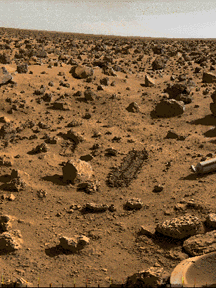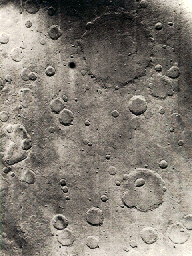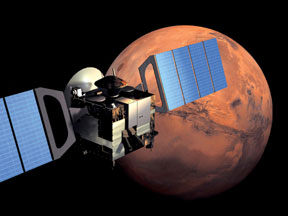This is a picture by an artist of the Mars Express spacecraft flying towards Mars.
Click on image for full size
Image courtesy European Space Agency (ESA) - Illustration by Medialab
Overview of the Mars Express Mission
The European Space Agency (ESA) launched a mission to Mars in
June of 2003. The mission is called "Mars Express". The Mars
Express spacecraft has two parts. One part will orbit Mars
for at least one Martian year. A year
on Mars lasts 687 Earth days, so it is longer than a year on Earth.
The second part of Mars Express is a lander
named "Beagle 2". Beagle 2 is supposed to land on Mars
on Christmas day in 2003.
Mars Express is looking for life on Mars. Scientists don't know whether
Mars has life or not. If Mars does have life, it is probably some kind
of microbe that lives in water. So scientists are looking for water on
Mars. Mars doesn't have any lakes, rivers, or seas. But Mars might have
water underground. Mars Express has a radar that can look through rocks.
Scientists hope to find water underground with that radar.
The Beagle 2 lander will look for life on the surface of Mars. It has
a robot arm that will scoop up dirt. It will check the dirt for chemicals
that might have been made by living things. Beagle 2 will land in a flat
area called "Isidis
Planitia" that is inside an old crater. There may have been a
lake inside the crater many years ago.
Beagle 2 is named after a famous ship called the H.M.S. Beagle. A scientist
named Charles Darwin sailed
on the H.M.S. Beagle about 170 years ago. Darwin helped invent a theory
called evolution that explains a lot about how life works. Scientists hope
to find out a lot about life if they discover life on Mars. So the Mars
Express team named their lander Beagle 2 in honor of Darwin's ship.
You might also be interested in:

What types of instructional experiences help K-8 students learn science with understanding? What do science educators teachers, teacher leaders, science specialists, professional development staff, curriculum designers, school administrators need to know to create and support such experiences?
...more
When we ask "Where might we find life outside of the Earth", the first place many scientists turn to is Mars. Mars may have been like the Earth in its past. No signs of life on Mars have been found, but
...more
You have seen water in lakes, rivers, and even your bathtub. But some water hides below the ground. It’s called groundwater! If you traveled underground deep enough, you would find that the rocks around
...more
This is an example of the cratered surface of Mars. Almost all of the surface of Mars is covered with craters. Craters can be wiped out over time, so a surface which has many craters is very old. The lowlands
...more
Charles Darwin was an English Naturalist who lived between 1809-1882. One of the most famous and influential scientists of all time, his ideas changed the ways all other scientists thought. Darwin started
...more
Russia and the United States have been sending spacecraft to Mars since 1960! Some of the coolest missions were Mariner 4, 6, 7, & 9, Mars 2, 3, 4, 5, & 6, the Viking missions, and the Mars Global Surveyor
...more
The Advanced Composition Explorer (ACE) was launched on August 25, 1997. How old were you when ACE was launched?
...more
To learn more about a specific mission from the Apollo program, the most successful and expensive space program in human history, select one of the links below: Apollo 1 Apollo 7 Apollo 8 Apollo 9 Apollo
...more















